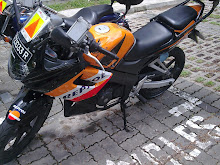In this session, our group, AMG (which is the acronym of our names : Arinto, M. Hamidullah and Gabriel) presented our proposed Jurong Bird Park Information Sytem. Actually the objective of this system is to provide unforgettable experience for Jurong Bird Park visitor. And the main obstacle is how to communicate the information about the bird/attraction effectively to the visitor. Jurong Bird Park had installed multilingual broadcasting speaker in its monorail but it is not currently in operation since the contractor is no longer able to maintain the system...
 To overcome this problem, we proposed AMG Information System for Jurong Bird Park which use bluetooth technology as the backbone of this solution.
To overcome this problem, we proposed AMG Information System for Jurong Bird Park which use bluetooth technology as the backbone of this solution. Refer to diagram beside, AMG provides 2 main services which called Blue-Info-Counter and Voice Recorded Information Service.
Blue-Info-Counter is a bluetooth-based solution. We plan to install many bluetooth access points in Jurong Bird Park where user with bluetooth capable cellphone can download th
- Location Information, this feature will inform the location of the Jurong Bird Park Visitor based on their nearest access point
- Text Information, this feature will send Jurong Bird Park Visitor with text-based information about the animal or other interesting things inside Jurong Bird Park
- Special Event Information, this feature will send information about Jurong Bird Park's special event such as Bird shows or other shows

- Video Information, visitor can download their desired information in video format, so they can stream it or store it in their cellphone
- Image Information, visitor also can download their desired information in image format, such as the image of specific bird or other species in Jurong Bird Park
- Species Locator, visitor can query location of specific species inside Jurong Bird Park, and the system will send the nearest bluetooth access point to the queried species
- Client Application, this is an application that will be installed in visitor's handphone to download the available contents inside all above features
Wisdom of Crowd (again)...
Yup yup, and in the start and end of our presentation, Prof. Gilbert gave us suggestion to enlarge the font. Yup, at that time we made the slide using Microsoft Visio and we didn't enlarge the default font. And in when the last group finished their presentation, Prof. Gilbert combined all our ideas into several common main idea using Wisdom of Crowd concept that we learned in our previous session.
Based on our class discussion, the common main idea is by using an application that installed inside the visitor's cellphone when they enter Jurong Bird Park(JBP) for the first time. This aspect is almost similar with OCBC Bank's 2nd factor authentication using cellphone. OCBC provides option to their customer to choose what kind of 2nd factor authentication that they want. One of them is by installing an application inside customer's cellphone. Here are the snapshot.


Use Case Diagram - from requirements to features... :D
Yup as the title states, Use Case diagram is used for describing all the system's features to fulfill the requirements or objective of the system. Let's go through 3 main ingredients of use case diagram.
- Feature of the system. This features is depicted as an oval shape as shown in our example about JBP information system. We put each feature inside 1 oval shape.
- Actor. Then we also have other entities that interact with our system. This outside entity is called actor. In our example the actor is the visitor of JBP. Usually actor is depicted as a human shape as shown in above example.
- System boundary. This ingredient is depicted as large rectangle that contains all the oval shape as the feature.

2 comments:
Very good contribution! Original, useful, well-written, nice diagrams and links to RW.
wah lucuuu.. information systemsnya jurong bird park...
tapi masih trauma nih ngeliat use case. pokoknya lagi trauma ngeliat smuanya yang berhubungan sama programming. hiiiii
Post a Comment